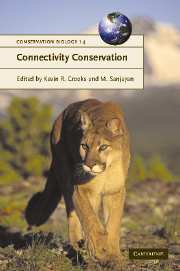Book contents
- Frontmatter
- Contents
- List of contributors
- Acknowledgements
- 1 Connectivity conservation: maintaining connections for nature
- PART I Approaches to connectivity research
- Introduction: Connectivity research—what are the issues?
- 2 Landscape connectivity: a return to the basics
- 3 Connectivity and metapopulation dynamics in highly fragmented landscapes
- 4 Genetics and landscape connectivity
- 5 Connectivity at the land–water interface
- 6 Influence of natural landscape fragmentation and resource availability on distribution and connectivity of gray wolves (Canis lupus) in the archipelago of coastal British Columbia, Canada
- 7 Migratory connectivity
- 8 Connectivity in marine ecosystems: the importance of larval and spore dispersal
- 9 Connectivity and wide-ranging species in the ocean
- 10 Hydrologic connectivity: a neglected dimension of conservation biology
- 11 Connectivity and ecosystem services: crop pollination in agricultural landscapes
- PART II Assessing connectivity
- PART III Challenges and implementation of connectivity conservation
- Index
Introduction: Connectivity research—what are the issues?
Published online by Cambridge University Press: 24 May 2010
- Frontmatter
- Contents
- List of contributors
- Acknowledgements
- 1 Connectivity conservation: maintaining connections for nature
- PART I Approaches to connectivity research
- Introduction: Connectivity research—what are the issues?
- 2 Landscape connectivity: a return to the basics
- 3 Connectivity and metapopulation dynamics in highly fragmented landscapes
- 4 Genetics and landscape connectivity
- 5 Connectivity at the land–water interface
- 6 Influence of natural landscape fragmentation and resource availability on distribution and connectivity of gray wolves (Canis lupus) in the archipelago of coastal British Columbia, Canada
- 7 Migratory connectivity
- 8 Connectivity in marine ecosystems: the importance of larval and spore dispersal
- 9 Connectivity and wide-ranging species in the ocean
- 10 Hydrologic connectivity: a neglected dimension of conservation biology
- 11 Connectivity and ecosystem services: crop pollination in agricultural landscapes
- PART II Assessing connectivity
- PART III Challenges and implementation of connectivity conservation
- Index
Summary
People began thinking about connectivity in a serious way when they recognized that fragmentation of habitats was a major threat to biodiversity. This recognition was crystallized in the 1960s by the development of island biogeography theory, which cast the issue in terms of islands immersed in a sea of inhospitable habitat. As the theory was applied to fragments in terrestrial settings, this binary view of habitat vs. not habitat was carried over to a patch-matrix view of the world. Fragments were viewed as clearly bounded elements set in a matrix of unsuitable habitats. Connectivity among such remnant habitat fragments should reduce isolation and provide buffering against local extinction and biodiversity loss. This is the premise of much of the thinking and research about connectivity in an ecological and conservation context.
It is difficult, however, to disentangle the effects of habitat fragmentation from those of habitat loss. Both empirical and theoretical analyses suggest that there is a fragmentation threshold when habitat loss reaches a certain level and a habitat becomes disconnected. Connectivity becomes important once this threshold is passed and fragmentation becomes widespread.
Our thinking about fragmentation and connectivity has been constrained by a strong terrestrial emphasis, and within that by an even stronger bias toward highly fragmented forest and woodland habitat in temperate zones. One of the challenges of connectivity research is to broaden the perspective, to determine how well the ideas developed in highly fragmented areas apply in places that are less fragmented, or in freshwater or marine environments.
- Type
- Chapter
- Information
- Connectivity Conservation , pp. 23 - 28Publisher: Cambridge University PressPrint publication year: 2006
- 14
- Cited by



